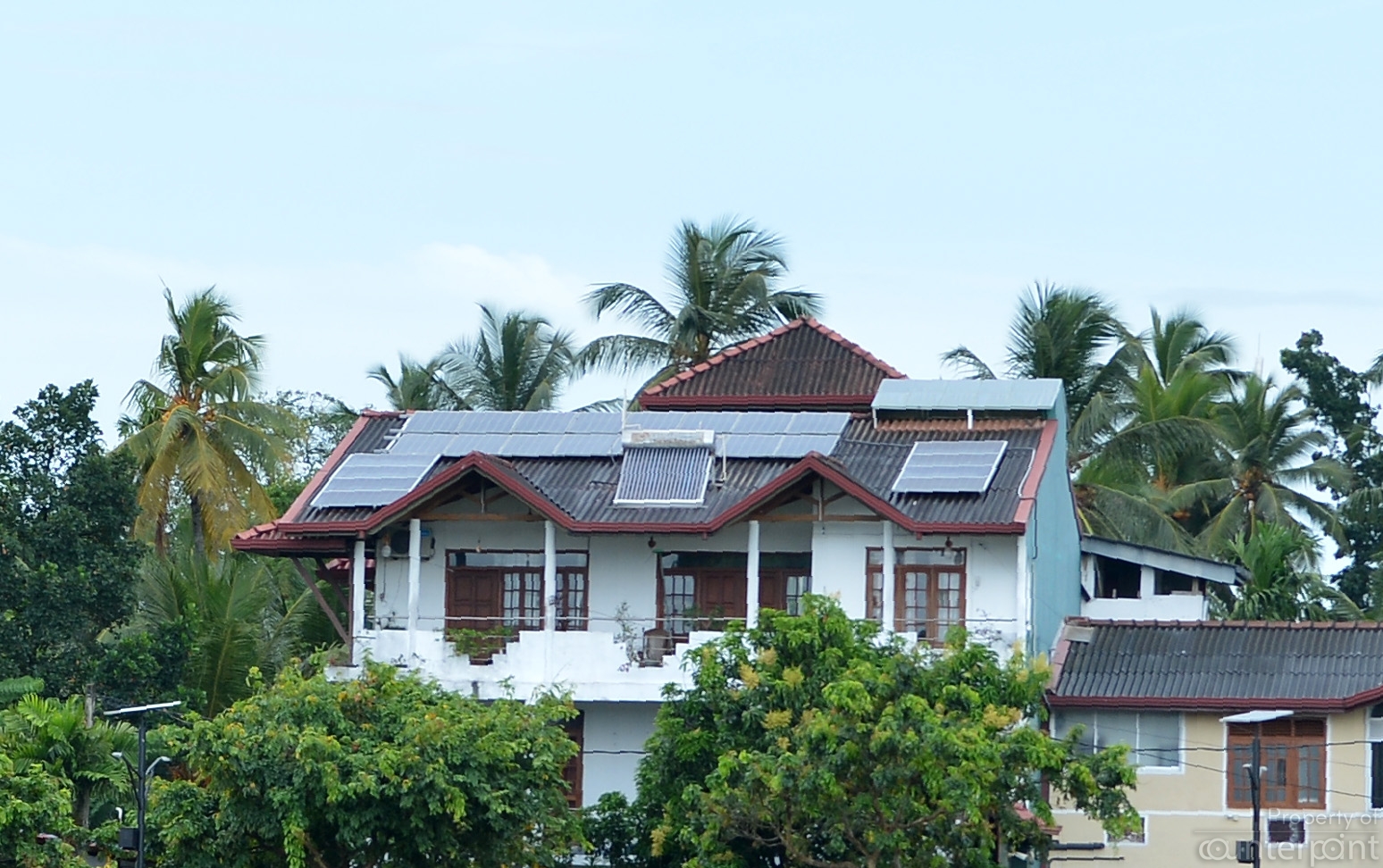
Inordinate delays in implementing renewable energy projects, mostly because it is claimed that politicians and bureaucrats are demanding kickbacks from investors are costing the country billions of rupees. This is despite the government’s stated commitment and policy to make the country “energy sufficient” by 2030.
The situation resulted in a former minister of power and energy, currently the Megapolis and Western Development Minister, Patali Champika Ranawaka calling for a Presidential commission of inquiry to investigate the cause for the delays, economic cost to the government, financial loss to the CEB(Ceylon Electricity Board) and to identify those directly responsible for this situation. His note to cabinet in May this year, also called for the appointment of a committee of academics and professionals to recommend solutions to the situation.
In his note he also debunked the claims made by the Secretary, Ministry of Power and Renewable Energy, in a memorandum submitted to Cabinet seeking approval to purchase high cost emergency power claiming that “2016, 2017 Hydro Power generation would be low.” Minister Ranawaka’s note states, “But real data shows otherwise. During the last decades, lowest Hydro Power generation had been observed 2012. The year 2017 rank is fourth with the highest Hydro Power generation. The real cause to the energy shortage would be the deliberate delaying of implementing the long-term generation plan.” As a former Minister of Power and Energy, Mr. Ranawaka must be aware of the true situation.
In this light, it can be surmised that the CEB and the Ministry of Power and Renewable Energy put together are amongst the most corrupt government institutions in the country.

By the time the coal mafia and the diesel mafia get into the sabotaging act ably supported by senior officers of the CEB and the power and energy ministry, the poor consumer ends up paying thousands of rupees more than they need to for their electricity. What’s more, they are denied their right to access cheap alternatives such as wind and solar power.
It seems that these groups are misleading the cabinet of ministers with the one scare phrase, “Power-cuts”, and leads us to wonder how competent and informed these ministers elected to govern the country are.
After many delays, two plans got the go ahead this week.
At the September 18 meeting, the cabinet approved the construction of the 300MW natural gas fired power plant in Kerawalapitiya. The plant was scheduled to be commissioned in January 2019, according to the Least-Cost Long Term Generation Expansion Plan (LCLTGEP) but is now expected to be ready in June 2020. According to estimates of the Public Utilities Commission of Sri Lanka, the monthly loss to the country owing to this delay is Rs. 1.55 billion.
With just a week to go for the cut-off date, September 27, Sri Lanka signed an agreement, also on September 18, with the Asian Development Bank (ADB) to obtain US$ 50 million loan to help fund the Rooftop Solar Power Generation project. The ADB had approved the loan in September last year, following a request by the government for a line of credit that would provide low interest rate loans for consumers to switch to solar energy.
The loan scheduled for implementation from January 2018 to December 2021 will fund subprojects of all types of rooftop solar radiation. The government’s plan is to see an increase in the capacity generated through solar radiation to 200 MW by 2020 and a 1000 MW by 2025 reaching a target of a million households by that time.
Keerthi Wickremaratne, Chairman, Sustainable Energy Authority of Sri Lanka (SEA) says that the US$ 50 million project would generate a total of 50 MW of solar power, which works out to around 70.08 GigaWatts hours annually. Until the project becomes functional, and diesel continues to be used to generate power instead of solar, the annual consumption will be 17,520,000 litres which in rupee terms would be a loss of over 2 billion rupees.
Despite the government’s commitment to steer the country towards utilising renewable energy to meet the growing demand for electricity and become an “energy sufficient” nation by 2030, informed sources told Counterpoint that this project has been straddled with snags with objections put forward by both the CEB and the Attorney General’s Department.
Under the “Battle for Solar Energy” program launched in September 2017, the government’s vision is to encourage as many households and industries to move towards electricity generation through solar radiation. While most high-income earners have already opted to use solar power in their homes, the request for the ADB loan was to facilitate more low and middle-income earners to also enjoy this benefit, and to also produce cleaner energy.
The proposal, says Mr. Wickremaratne is a ‘win-win’ situation for both the consumer and the CEB. Consumers will have the ability to sell the excess power they generate to the CEB at the rate of Rs. 22 per KWh in the first seven years and at Rs. 15.50 per KWh during the next 13 years. “In the 20 year period, this works out to the CEB paying the consumer an average of Rs.19.82 per KWh, he said, adding that in 20 years that rate the CEB would be paying out will ensure a clear profit for itself as opposed to the billions of rupees spent on using diesel to generate power plants. As reported by Counterpoint in our July 2018 issue, business tycoons in the private sector have been gaining the benefit of the CEB‘s continued failure to purchase the retired diesel powered power plants as instructed by Cabinet, instead, opting to lease them at enormous cost to the country.

While there had been no objections to the Rooftop solar project at the start, the CEB had pointed out that unless tenders are called for, it would be in violation of the Electricity Act. This view had been backed by the Attorney General’s department as well to ensure transparency. This is an interesting objection; as we reported in July this year, the CEB had no qualms in continuously renewing agreements with Independent providers for diesel powered electricity generation, without calling for tenders. As well, when the project will only involve the CEB and the consumer, one may ask why tenders must be called.
Mr. Wickremaratne pointed out that a bidding process for this project is not necessary as the CEB will be purchasing the excess electricity produced by all consumers and not a selected few and everyone will be paid for the excess energy generated at the rate determined. CEB sources Counterpoint spoke to were also sceptical about the ability for consumers to store the excess energy as that would require special batteries. Mr. Wickremaratne countered that more advanced batteries are available for inclusion in the grid-connected residential projects and, that a committee has been set up to recommend tariff concessions on these. “Around the world, the switch to renewable energy is catching on, but we are insisting on staying with diesel, the most polluting and expensive method of generating electricity” he said. The advantage of storing solar power also means that it would be available to consumers at night time and also if the grid fails.
Are the objections to these projects because ordinary citizens who would invest in solar panels for their electricity would not have the wherewithal to make multi-million rupee kickbacks?
The ADB announced its agreement to provide the loan following a fact finding mission in May 2017, where it observed that “high share of thermal power in the generation mix, (17% of oil-fired and 34% of coal fired generation) creates a high cost base and is not a viable and sustainable solution to energy security and environment protection in the long term.”
With the demand for electricity expected to increase by 4-6% per year, pursuing the renewable energy option, in this case solar, a readily available resource at low cost will allow for a clean and reliable supply of energy. Sri Lanka’s geographical location places it in the most optimal position, even better than India for solar generation, Mr. Wickremaratne said, adding that except for the central hilly region, solar power is directly accessible in the rest of the country. The Indian company which set up a ground mounted solar power plant in the South of the country had pointed out that owing to the location, Sri Lanka can produce 30% more solar energy than India.
The one project recently sent by the CEB to the Minister of Power and Renewable Energy is yet to obtain cabinet approval; the US $ 140 million plan to build a Wind Farm in Mannar for which tenders were called in May this year. CEB sources told Counterpoint that though the tender was granted to Vestas Asia Pacific A/S, Denmark and all procedures duly completed, it had not yet been submitted to the Cabinet though the documents had been given to the Minister. Timing is crucial in this project they said, explaining that the actual hoisting of the blades of the wind towers cannot be done when there is heavy wind. The South-West monsoon runs from May to October, and if the already delayed project is to be completed by 2020, they need to get cracking by October this year, CEB sources added.

According to the LCLTGEP the commissioning of a 50 MW wind power plant is scheduled for January 2019, and the 100MW (Mannar) and 120 MW (Pooneryn) scheduled for 2020. Minister Ranawaka’s note points out that a delay each month in commissioning the wind power projects results in a Rs. 0.75 billion loss. He adds that at the time of writing his note to the cabinet, tenders for only the 100MW plan had been called.
Sticking with renewable energy sources including wind and hydro, means reducing dependency on fossil fuels. “Sixty five per cent of the foreign revenue of this country, monies earned by mostly migrant workers, is utilized by the Petroleum and Power and Renewable Energy ministries, Mr. Wickremaratne said, adding that the country is looking at financial and environmental ruin, the longer the projects are delayed.
There is a clear financial benefit of moving away from diesel and coal. However, if one monetises the advantage to the environment it is a no brainer.
In the case of solar power, the clean power generation capacity is placed at 60MW, which means a yearly energy generation of 84,000 MWh which is equivalent to avoiding the emission of almost 64,500 tons of carbon dioxide a year.
Despite a 20 year plan to move towards least cost and environmentally clean energy sources, delays created by officials and politicians push back the commissioning of projects and the country is nowhere near to meeting the 2019 targets. The financial losses run into the billions, as Minister Ranawaka notes, a two year delay in the wind power project carries an estimated loss of Rs 18 billion and Rs. 10.8 billion in the case of solar.
It is clear that many politicians and bureaucrats, wined and dined by the corrupt are blithely leading the country to further economic and environmental ruin with scant respect for the government’s policy of making Sri Lanka an “energy sufficient” nation. The question ordinary citizens ask is what action the government will take to arrest this situation.




